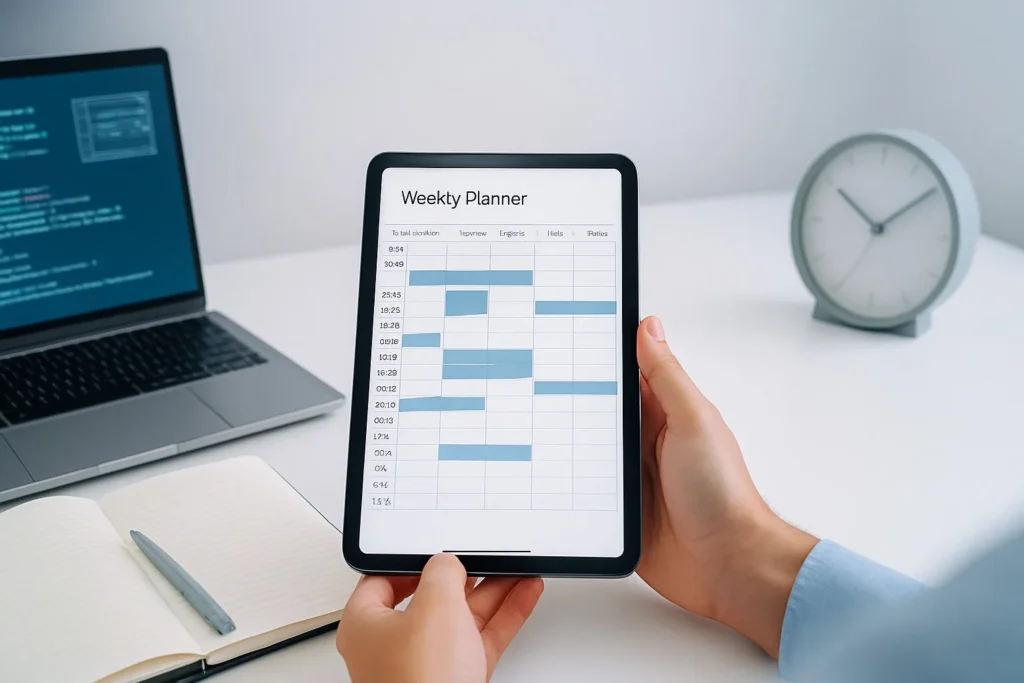
Have you ever felt like you’re constantly racing against the clock, juggling work, errands, and everything else life throws at you? It’s exhausting, right? I’ve been there too, and I know how overwhelming it can feel when your to-do list seems endless. But here’s the thing—with just a little bit of planning, you can take back control and turn that chaos into clarity.
If you’re just starting out and looking for simple, effective ways to get organised, this guide is for you. Together, we’ll explore practical tips to help you tackle your day, feel less stressed, and accomplish more—without feeling like you need to do it all at once.
Let’s dive in and discover how even the busiest person can master the art of planning using these simple steps!
Before you dive into planning, take a moment to define what success looks like for your day. Ask yourself:
⦿ What are my most important tasks today?
⦿ How do I want to feel by the end of the day?
✅ Set Priorities: Identify 1-3 key goals for your day. These are your non-negotiables.
✨ Visualise Success: Picture how completing these tasks will positively impact your life. Motivation starts with a purpose!
🔑 Make It Tangible: Use a tool that resonates with you, like a vision board, a simple sticky note with your goals, or even a productivity app to keep your key objectives front and centre. For example, apps like Evernote or Notion can help you map out your day visually and keep you focused on your vision.
Not all planning tools are created equal, and that’s okay. The key is finding what works best for you.
🔑 Digital Planners: Try apps like Todoist or Google Calendar for easy scheduling and reminders.
🔑 Paper Planners: Prefer the old-school method? A simple notebook or dedicated planner can help you stay on track.
✨ Pro Tip: Keep your planner or app accessible so you can jot down tasks and ideas as they come.
Trying to tackle an endless to-do list can feel daunting. Instead, break your day into manageable parts:
✅ Morning: Focus on high-energy tasks and set the tone for the day.
✅ Afternoon: Handle routine or collaborative tasks.
✅ Evening: Reserve time for reflection and planning tomorrow’s goals.
Time blocking is a game-changer for busy people. Instead of creating a generic to-do list, allocate specific blocks of time to each task.
✨ Example: Dedicate 9:00-10:00 AM for emails, 10:00-11:30 AM for a major project, and so on.
🔑 Why it works: Time blocking keeps you focused and prevents tasks from spilling over into the rest of your day.
Do you have small tasks that linger on your list? Here’s a quick fix:
✅ If a task takes less than two minutes, do it immediately.
✨ Examples: Replying to an email, filing a document, or making a quick phone call.
This simple rule clears mental clutter and frees up your focus for bigger tasks.
Life doesn’t always go as planned, and that’s okay. Build a buffer into your schedule to handle surprises.
🔑 Schedule Flex Time: Leave 15-30 minutes between tasks to regroup or tackle unforeseen challenges.
✨ Pro Tip: If your day goes off track, revisit your priorities and adjust as needed.
Before you call it a night, take five minutes to review your day. Reflect on:
✅ What went well? Celebrate your wins, big or small.
✅ What could improve? Identify areas for adjustment tomorrow.
✨ Bonus: Use this time to prepare your plan for the next day, so you wake up feeling organised and ready to go.
Planning doesn’t have to be complicated. By starting small, choosing the right tools, and staying flexible, you can transform even the busiest day into a productive one. Remember, the goal isn’t perfection—it’s progress.
Ready to take charge of your day? Start with one tip from this guide and see how it changes your routine. For more practical tips, check out [Link to related article]. You’ve got this!
Begin your journey to a stress-free day today! Share your favourite planning tips in the comments or explore our productivity resources for more inspiration.
There are no results matching your search